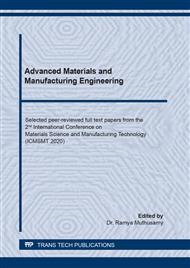[1]
A. Priyanka, K. Kulkarni Effect of replacement of natural sand by manufactured sand on the properties of cement mortar', IJCSE, volume 3, issue3.
Google Scholar
[2]
Ali N. Alzaed Effect of Iron Filings in Concrete Compression and Tensile Strength, International Journal of Recent Development in Engineering and Technology (ISSN 2347 - 6435) Volume 3, Issue 4, October (2014).
Google Scholar
[3]
Festus Adeyemi Outage, Strength properties of concrete produced with iron fillings as sand replacement" Article no: -29938, BJAST (2016).
Google Scholar
[4]
Gunalan vasudevan Performance on used iron sand as concrete admixture, CBEE,(2016).
Google Scholar
[5]
IS 456-2000- Plain and Reinforced Concrete - Code of Practice.
Google Scholar
[6]
IS 10262-2009 – Concrete Mix Proportioning - Guidelines,, Bureau of Indian Standard, New Delhi.
Google Scholar
[7]
IS 10262: 2009 – Concrete Mix Proportioning - Guidelines,, Bureau of Indian Standard, New Delhi.
Google Scholar
[8]
IS 12269:2013 – Ordinary Portland Cement 53 grade – specifications,, Bureau of Indian Standard, New Delhi.
Google Scholar
[9]
IS 456: 2000 – Plain and Reinforced Concrete Code of practice,, Bureau of Indian Standard, New Delhi.
Google Scholar
[10]
Jadhav Effect of replacement of natural sand by manufactured sand on the properties of cement mortar', IJCSE, Volume 3, issue 3.
Google Scholar
[11]
K.U. Manikandan Effect of replacement of by M-Sand in high strength concrete, IJMTER, Volume 2, issue 2,(2015).
Google Scholar
[12]
M. Adamson Experimental investigation on the effect of M-Sand in high performance concrete, American. J. Engg. Res., Vol.2, Issue 12, (2013).
Google Scholar
[13]
M. Adams Joe, P. Brightson, M. Prem Anand, A. Maria Rajesh Experimental investigationon the effect of m-sand in high performance concrete, American J. Engg. Res. Vol.2, issue 12, (2013).
Google Scholar
[14]
M. Adamsjoe Experimental investigation on the effect of M-Sand in high performance concrete, American. J. Engg. Res., Vol.2, Issue 12, (2013).
Google Scholar
[15]
Manjunatha M Durability Studies on Concrete by Replacing Natural Sand with M-Sand A Review,, International Journal of Emerging Technology and Advanced Engineering VOL.6, ISSN 2250-2459. Issue 3, March (2016).
Google Scholar
[16]
N. Alzed Effect of iron filings in concrete compression and tensile strength, ISSN2347- 6435, Volume3, Issue 4.
Google Scholar
[17]
Nimitha. Vijayaraghavan Effect of manufactured sand on durability properties of concrete,. American. J. Engg. Res, Vol. 12, Issue 12, (2013).
Google Scholar
[18]
P. Shanmugavadivu, R. Malathy Durability properties of concrete with natural sand and manufacturing sand,. ICSE (2011).
Google Scholar
[19]
R.D. Patel Strength analysis of concrete by using iron slag as a partial replacement of normal ggregate (coarse) in concrete,.
Google Scholar


